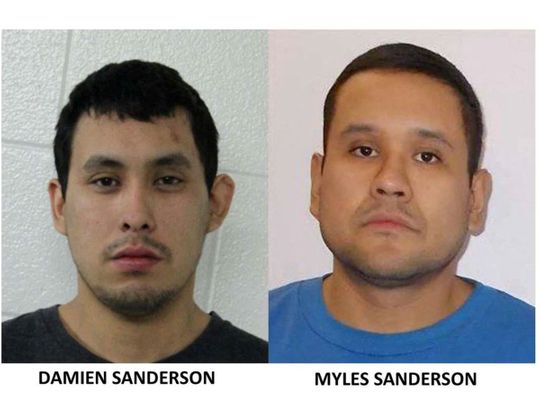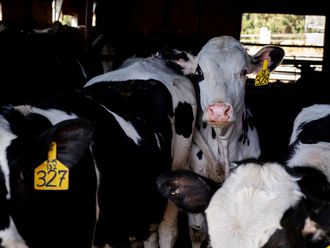
Saskatchewan: The suspect sought by Canadian authorities in a weekend stabbing spree that killed 10 people in and around an indigenous reserve was arrested on Wednesday but suffered unspecified "medical distress" and died a short time later at a hospital, police said.
Official word that the four-day manhunt for Myles Sanderson, 30, ended with his death came during a late-night news conference hours after the Royal Canadian Mounted Police (RCMP) reported he had been taken into custody.
The RCMP said the arrest took place near the town of Rosthern, Saskatchewan, about 100 km (62 miles) southwest of the area where one of the bloodiest acts of mass violence in the country's history unfolded on Sunday.
Canada's Global News agency, citing multiple law enforcement sources, later reported that Sanderson had surrendered to police and was taken away alive in an ambulance after a highway pursuit in which police rammed his vehicle off the road. Global News said he died shortly afterward of unspecified injuries that authorities believe were self-inflicted.
RCMP Assistant Commissioner Rhoda Blackmore told reporters Sanderson "went into medical distress" shortly after he was detained, that emergency medical personnel on the scene attended to him and he was taken to a hospital, where he was pronounced dead.
She declined to address questions about whether he might have consumed a drug or other substance that killed him, saying the manner and cause of his death would be determined by an autopsy.
His older brother and accused accomplice, Damien Sanderson, 31, was found slain on Monday in a grassy area of the James Smith Cree Nation. Police were investigating whether the younger sibling might have killed his brother, and that he may have sustained an injury requiring medical attention.
Blackmore said an emergency-911 caller who reported spotting Myles Sanderson before his arrest indicated he appeared to have had a visible injury.
A massive manhunt for two brothers believed to be responsible for the killings on Sunday had spread across Canada's vast Prairies region.
Authorities said he likely had been killed by his sibling, Myles Sanderson, 32, who remained a fugitive until his arrest near Rosthern town in Saskatchewan.
Myles Sanderson is also wanted for breaching parole in May after serving part of a sentence for assault and robbery.
'Senseless act'
With no known motive for the attacks, relatives of victims spoke out on Wednesday about their "nightmare" and called for answers from authorities.
Mark Arcand said the killings that claimed the lives of his sister Bonnie Burns, 48, and her son Gregory Burns, 28, were a "horrible, senseless act."
"We're broken," he said, describing feelings of anger and sadness. "It still feels like it's a nightmare. It doesn't feel real."
"How did this happen to our family? Why did it happen? We have no answers," he told a press conference. "We just know that our family members were killed in their own home, in their yard."
Arcland recounted how his sister had rushed out of her house to help her son, who was bleeding out in the driveway of their home after being stabbed several times.
"She was stabbed two times, and she died right beside him," he said. "She was trying to protect her son."
A neighbour ran over to try to stop the assailants, but she was also stabbed to death, he said.
The family and the community, Arcland added, has "a steep hill to climb, and we're going to climb it together, united."
The Saskatchewan Coroner's Service has released the names of the deceased victims - six men and four women aged 23 to 78 years old.
All but one were members of the Cree community. The other was a widower who lived with his adult grandson in nearby Weldon.
Several vigils were scheduled for Wednesday evening.
Those wounded in the attack were 17 adults and one young teen, police said. Among them was another son of Bonnie Burns who was slashed in the neck.
Several of the deceased had been identified by families and friends on social media, including a veteran, an addiction counsellor, and a mother of two who worked as a security guard at a local casino.
Police believe some of the victims were targeted and others were attacked randomly.
Ten people - some of whom had been airlifted on Sunday - remain hospitalized, including three in critical condition, according the Saskatchewan Health Authority. Seven others have been discharged.
Sanderson has a history of violence that began in his youth and continued with "no significant breaks" for nearly two decades, the Parole Board of Canada said in February, according to a document obtained by The Washington Post.
Physical abuse
The board said Sanderson and his siblings grew up in an environment where physical abuse and domestic violence was commonplace, and he began using drugs and alcohol as a boy.
“You . . . said that your regular use of cocaine, marijuana and hard alcohol would make you 'lose your mind' and that you can be easily angered when drunk, but are a different person when sober,'" the board wrote.
It noted his Indigenous background and listed several factors that might have contributed to his involvement in the criminal justice system, "including intergenerational impacts of residential schools, neglect, exposure to familial and community substance abuse, your own substance abuse issues, exposure to/experiencing domestic violence during your childhood, family fragmentation, lack of education, and loss of culture/spirituality.”
The board said he had 59 convictions as an adult for crimes including assault, assault with a weapon, assaulting a peace officer and robbery, for which he had been serving a prison sentence of four years and four months. Judges imposed a lifetime prohibited-weapons order on him.
In one incident in 2017, the board said, he barged into the home of his ex-partner and acted "in a threatening manner," frightening two of his children who had been sleeping upstairs, and throwing cement blocks at a car and through a side window.
In another, a few days later, he threatened to murder an employee at a First Nations band store and to burn down the house belonging to the man's parents.
In 2018, while drinking, he stabbed two men with a fork and then beat another unconscious. Also that year, he kicked a police officer in the face and head repeatedly while he was being placed into a police car.
Sanderson received a statutory release, which is mandated by law for some offenders who have served two-thirds of their sentences and have not been granted full parole, in August 2021. It allows them to serve the rest of their sentence under supervision in their community. One assessment found that he was a medium-to-high risk to reoffend.
Conditional release
He was required to follow several conditions: He could not use drugs or alcohol, he had to follow a treatment plan for substance abuse and violence, and he could not enter into relationships with women without the permission of his parole officer.
His release was suspended in November after his parole supervisor learned that he had been living with his ex-spouse and children in violation of the conditions, according to the parole board. It canceled the suspension in February and issued a reprimand.
The board said he seemed to have maintained sobriety during his release, had obtained a job and a house for his family, was engaged in cultural ceremonies, and "appeared to have been making good progress on reintegration."
"It is the Board's opinion that you will not present an undue risk to society if released on statutory release and that your release will contribute to the protection of society by facilitating your reintegration into society as a law-abiding citizen," it said.
Drugs and alcohol blamed
Ivor Wayne Burns of James Smith Cree Nation said three of the victims - his sister Gloria Lydia Burns, a woman and a 14-year-old boy - died at a single location.

State of emergency
The nation's elected elders declared a state of emergency "in response to the numerous murders and assaults on members of the James Smith Cree Nation," and established two emergency operations centers, the nation said in a statement.
Indigenous people account for less than 5% of Canada's population of about 38 million and suffer from higher levels of poverty, unemployment and a lower life expectancy than other Canadians.
Trudeau said his government had been in direct communication with the James Smith Cree Nation leadership, adding, "We are ready to assist in any way we can."
The first stabbings were reported at 5:40 a.m. (1140 GMT) and within three hours police issued a province-wide dangerous persons alert. By the afternoon, similar alerts were also issued in Saskatchewan's neighboring provinces Alberta and Manitoba.












